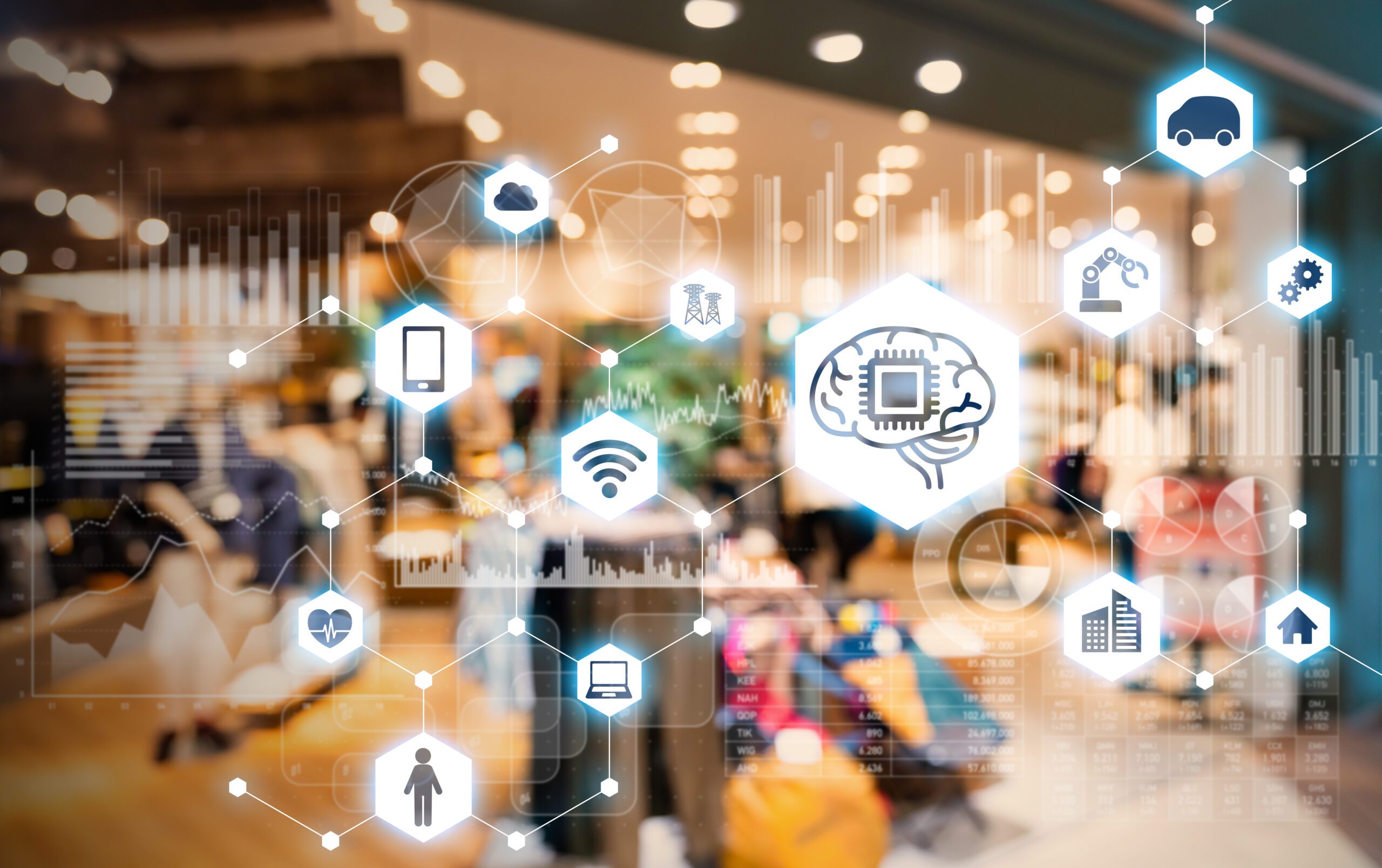As we move through the second half of the year, 2022 is on track to prove a difficult-yet-rewarding journey for retail. Customers now expect more convenience and speed than ever before, amid intense competition and uncertain times. It can be tough for a retailer to keep on top of IT. But retail innovation to connect with customers and streamline logistics is essential for retail vendors in the face of unprecedented challenges.
British vendors face a host of issues impacting the retail industry this year. Inflation has become a global problem in the wake of pandemic policies, and retail volume has dropped in response. The unending complications of Brexit and the Northern Ireland protocol add border issues that further interfere with imports and exports.
Looking abroad, the Russo-Ukrainian war shows no sign of concluding anytime soon, keeping the world on edge and throwing a wrench in major food supply chains. Meanwhile, China continues to enforce strict Covid-19 lockdowns, which severely affect international business hubs like Shanghai and disrupt international supply lines. Products are piling up in warehouses, cargo ships, and stores.
Adding to the woes is the difficulty retailers have finding employees, due to the so-called “Great Resignation”—the mass departure of people from work during the Covid-19 pandemic. Nearly one in twenty Brits resigned last year alone! Pushed by economic forces including inflation as well as by personal motives, people no longer dance to the same old retail tune.
To confront these challenges, vendors need to rise to the occasion with new technology. Giving customers what they want, when they want it, and where they want it—even through the chaos—requires dynamic and intelligent systems. Companies should plan with an eye toward emerging trends like artificial intelligence, data-driven demand forecasting, integrated logistics management, and automation this year.
1. AI Innovation Paves the Way for More Personalised Retail Customer Experiences
After decades of research and innovation, artificial intelligence (AI) is now rapidly expanding to become a key part of retail (and the wider economy). AI provides vendors with sharper insights into shoppers’ desires and behaviours, allowing to retailers offer a more personalised customer experience.
For example, consider how companies like True Fit use AI to analyse shopper behaviours and make product recommendations for clothing retailers. The technology combs through customer information—including clothing sizes and demographic data—and then gives people purchase ideas to fit their preferences. Vendors can embed this functionality to increase sales and reduce returns.
Artificial intelligence also enables financial strategies like “buy now, pay later” and loans to empower shoppers at check-out. For instance, Klarna assesses shoppers’ creditworthiness through information technology before calculating the instalments they can pay. The financing assistance makes it easier to afford purchases. AI can better identify opportunities like this that would have gone unnoticed, opening new revenue streams.
Many online retailers now use chatbots to deliver information more cost-effectively and securely than before. AI also recommends personalised products in online shopping carts to decrease abandonment. And throughout this entire sales process, AI also works to detect and prevent fraud, using behaviour and pattern tracking to identify suspicious activity. And as technology advances further, AI’s potential in retail will only continue to expand.

2. Data-Driven Demand Planning
Retailers face the harrowing task of planning in a highly unpredictable world. Data is key for making any forecasts—a data-driven plan is simply more accurate, encouraging balanced supply chain management and tighter customer relationship management.
But demand planning is tricky enough in a stable environment; in a crisis, it becomes even more of a challenge. Fortunately, advanced technological solutions now coming to the market allow retailers to take advantage of hidden opportunities. The tools and solutions for data-backed analysis have advanced tremendously; new techniques can help drive sourcing and procurement in even the most uncertain times.
Businesses can use sales data—including indicators for seasonality, current events, and more—to make better predictions and stay ahead of the competition. For example, analytics can tell retailers when and where to send more stock. Various signals can suggest proactive choices to put products in shoppers’ hands, instead of leaving people disappointed. You can also coordinate more nuanced and extensive marketing programmes with your data-driven demand planning.
With more data available now than ever before, digging through the numbers to extract useful insights can be a complex and time-consuming process. You need fast and precise plans to keep up with the pace of modern business. The more efficiently you can extract value from your collected data, the better situated you are to conquer the retail market—and new analytics innovation can help.
3. Seamless Logistics Management Through Integrated Systems
Retail success depends on logistics. Interconnections among your disparate systems bring together retail processes to improve delivery, ensuring that products move efficiently. But in order to maximise efficiency, you need to integrate these internal and external systems as much as possible—and Prolifics can help.

Integration enables multiple complementary fulfilment channels: you can sell from warehouses, stores, online, and directly from suppliers all just as efficiently. This extends your product and customer range, without sacrificing speed. For instance, with highly-integrated logistics, you can sell popular clothing sizes from your warehouse and backfill uncommon sizes from suppliers, without running up storage costs or slowing down the customer.
Integration also shortens customer delivery lead times and reduces returns, since you operate multiple routes simultaneously through a standardised process. It’s like upgrading from scattered country roads to the national highway system.
Logistics management starts with getting your data in order. For example, you can use a solution like IBM Cognos, which incorporates Watson artificial intelligence, to simplify and join your input data to produce informative visualisations and forecasts.
Building on your ordered data is an integration platform, such as IBM Cloud Pak, which bridges on-premises and cloud infrastructure. From there you can share data with business partners and third-party aggregators as necessary. Data goes from multiple sources to wherever it does the most good.
As an example of how integration can help, consider how the UK’s go-to retail logistics provider Clipper integrated its systems with Prolifics. Modernising systems and implementing new tech innovation sped up onboarding substantially. Internal and external systems now work hand-in-hand, allowing Clipper and the retail partners they serve to scale and expand services.
4. Address Supply Chain Issues With Automation
When it comes to the supply chain issues wrought by the 2020 shutdowns, nowhere around the world went untouched. Even two years later, businesses are still struggling to get back on their feet. Given the magnitude of the disruption, however, it’s also opened up a golden opportunity for retail vendors to invest heavily in automation innovation. No longer just the domain of big business, now small and medium enterprises are also automating processes. There are tools fit for the specific jobs you need, ready to act as your workforce multipliers.

When it comes to automating your supply chain, look for tools that can speed up rote tasks you might have previously handled manually. For example, when processing returns and refund requests for approval, handling each case by hand takes considerable time—and time is money. Automating this process cuts out unnecessary costs while assisting more customers. You can also scale this service depending on business fluctuation, to optimise your expenditures.
The same advantages apply to processes before the purchase is made, too. Chatbots can automate order checking and other mundane-yet-costly tasks. Retailers are also automating customer engagement strategies (think personalisation emails and social media encounters) to increase sales.
As you accumulate data from business operations, you’re developing a valuable repository of data—that often goes unrecognised by businesses. Use automation tools to mine this data and improve business processes. The ensuing gains in efficiency may yield substantial long-term cost savings.
Workflow and document automation involves changing long-running tasks like data capture and distribution and moving away from legacy systems. Newer event-driven processes react to information as soon as received, thereby bolstering automation. When a purchase order comes in, it triggers responses on the basis of data such as the purchaser and the category of item. This enables the system to send the order to the right department all on its own.
In the next few years, over three-quarters of supply chain application vendors will include advanced analytics, AI, and techniques like machine learning.
Now is the time to upgrade to automation—before your competition catches up.
Go Digital With Prolifics
Digital retail innovation is critical to survival in the retail industry. Companies need to keep pace with technology trends—from the supply chain through to the customer experience—to optimise performance. Partnering with a proven digital transformation leader like Prolifics gives retailers of any size or technical experience an edge.
Whether you want to adopt the API-first approach to integrating systems or modernise with AI, it makes sense to collaborate with digital transformation professionals. Prolifics has helped businesses across the UK make the digital jump—and yours could be next! Our decades of experience are at your disposal.
Are you ready to leap into the digital future? Reach out and see how Prolifics can make your retail operations smarter, faster, and more profitable today.









